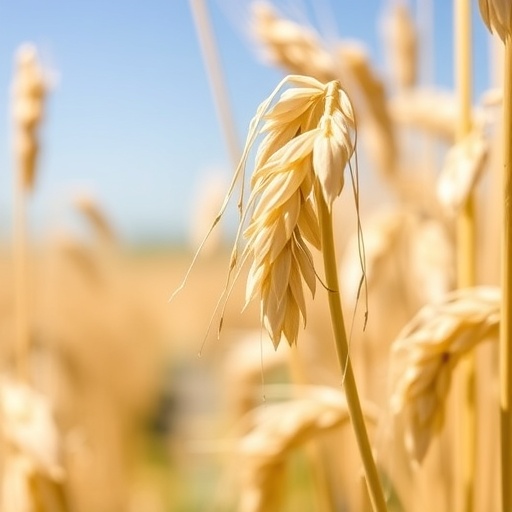In a groundbreaking advancement poised to reshape the future of cereal crop breeding, researchers from prominent institutions including the Technical University of Munich (TUM), Helmholtz Munich, and the Leibniz Institute of Plant Genetics and Crop Plant Research (IPK) have successfully decoded the pan-genome of hexaploid oat. This endeavor, detailed in a recent publication in the journal Nature, encapsulates the extensive genetic diversity of 33 oat lines sourced globally, ranging from modern cultivars and traditional landraces to wild oat species. This ambitious project not only maps the collective genomic landscape of oat but also charts gene expression patterns through a complementary pan-transcriptome analysis, unveiling a complex biological tapestry with direct implications for breeding climate-resilient, high-yielding oat varieties.
Oats, scientifically classified as Avena sativa, represent a vital cereal crop globally prized for their nutritional benefits, including high fiber and essential micronutrients, as well as their versatile use in food and feed industries. Despite their significance, oat research has historically lagged behind major cereals like wheat and rice. However, as climate change imposes unprecedented challenges on agricultural systems—manifested through increased temperatures, prolonged droughts, and emergent pathogens—the urgency to deepen our genetic understanding of oats has never been higher. The current study addresses this gap by constructing a pan-genome, which is not merely an aggregate of one reference genome but a comprehensive collection encompassing all genetic sequences present across the studied oat lines.
The concept of a pan-genome transcends traditional genomics by capturing the full spectrum of genetic variability, including presence-absence variations and structural polymorphisms that are often overlooked in single reference assemblies. In this work, the team sequenced and analyzed the genomes of 26 cultivated oat lines—including historical landraces and experimental breeding materials—and seven wild oat accessions. By integrating this mosaic of genetic backgrounds, the pan-genome effectively reveals both core genes conserved across all lines and dispensable genes unique to select populations. Such genetic elements can underlie important agronomic traits like drought tolerance, pathogen resistance, and yield potential, which have often been inadvertently lost or reduced in modern breeding programs focused predominantly on productivity.
Complementing the genomic sequencing, the researchers deployed pan-transcriptomic profiling to delineate gene expression patterns across different tissues and oat lines. This approach is groundbreaking in its ability to identify which genes are actively transcribed and regulated in context-dependent manners, offering novel insights into adaptation mechanisms at the molecular level. Fascinatingly, gene-expression variations were found to correlate closely with the geographic origins of the oat lines, implicating localized environmental pressures as drivers of regulatory evolution. Such detailed gene activity maps empower breeders to recognize molecular signatures linked to climatic resilience traits, thus steering selection and introgression efforts towards ideotypes optimized for future environmental conditions.
The hexaploid nature of oat adds a further layer of complexity and scientific intrigue. Hexaploidy, involving six sets of chromosomes, can confer genetic redundancy and plasticity, enabling swift evolutionary responses. Yet, it also poses technical challenges for genome assembly and annotation due to the high degree of sequence similarity among homeologous chromosomes. The research team leveraged state-of-the-art sequencing technologies and innovative bioinformatics pipelines to meticulously disentangle these genomic intricacies. Their efforts culminated in high-quality reference assemblies for individual oat lines, which collectively inform the broader pan-genome framework with unprecedented resolution and accuracy.
Beyond basic research, these findings bear immediate practical implications. Modern oat breeding is confronted with a narrow genetic base stemming from decades of selection for yield under temperate conditions, which risks exacerbating vulnerability to shifting climate patterns. By illuminating the genetic reservoirs residing in both wild relatives and heritage landraces, the pan-genome serves as a vital genetic repository from which novel alleles conferring drought tolerance, disease resistance, and phenological adaptability can be harnessed. This resource catalyzes precision breeding strategies, including genomic selection and gene editing, tailored to fortify oat performance under multifactorial stresses anticipated in the coming decades.
Moreover, the integration of gene expression data into this genomic framework—forming what the authors term the pan-transcriptome—adds a functional dimension that transcends DNA sequence alone. This dynamic directory of gene activity across diverse tissues and experimental conditions facilitates the identification of regulatory networks and epigenetic mechanisms underpinning phenotypic plasticity. Such insights not only enhance our biological understanding of oat but also refine the selection criteria used in breeding programs to encompass adaptive gene expression patterns, a crucial factor for crop resilience.
The study’s international collaboration and extensive sampling strategy underscore the importance of global cooperation in addressing food security challenges. By incorporating germplasm from wide geographic origins, the researchers have ensured that the pan-genome reflects a comprehensive genetic panorama, thereby maximizing its utility for oat improvement worldwide. These efforts exemplify a paradigm shift from monocentric breeding models to integrative approaches that respect and exploit the evolutionary history embedded in agrobiodiversity.
Looking ahead, the availability of this pan-genome and pan-transcriptome resource is expected to accelerate functional genomics studies in oats, facilitating the discovery of causal genes and allelic variants for traits of agronomic importance. It also sets a precedent for similar approaches in other crops, particularly those with complex polyploid genomes. The researchers emphasize that while oats occupy a smaller market share compared to global staples, their nutritional profile and role in diversified cropping systems render them indispensable assets in fostering sustainable agriculture and dietary diversity.
Notably, this research also sheds light on the evolutionary dynamics of gene regulation in polyploids, offering a valuable model system for plant biologists investigating genetic and epigenetic adaptation processes. The intricate interplay between genetic content and transcriptomic plasticity illustrated here will inform broader theoretical frameworks on plant resilience and evolutionary biology.
In essence, the unveiling of the hexaploid oat pan-genome and pan-transcriptome represents a landmark achievement propelling oat breeding into a new era of data-driven innovation. By harnessing the full breadth of oat genetic diversity and its functional expression, scientists and breeders are now better equipped to confront the pressing challenges of climate change, enhance crop performance, and secure global food supplies for generations to come.
Subject of Research:
Article Title: A pangenome and pantranscriptome of hexaploid oat
News Publication Date:
Web References: http://dx.doi.org/10.1038/s41586-025-09676-7
References: Nature, DOI: 10.1038/s41586-025-09676-7
Image Credits:
Tags: agricultural systems and sustainabilitycereal crop research advancementsclimate-resilient oat breedinggene expression patterns in oatshexaploid oat pan-genomehigh-yielding oat varietiesimpact of climate change on agriculturemodern oat cultivars and landracesnutritional benefits of oatsoat genetic diversityoat research challenges and opportunitieswild oats genetic study






